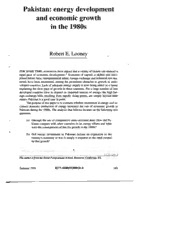
DTIC ADA528518: Pakistan: Energy Development and Economic Growth in the 1980s PDF
Preview DTIC ADA528518: Pakistan: Energy Development and Economic Growth in the 1980s
Vol. XIX. No.2 Summer 1995 Asia-"'acific LNG markel: oLillook 10 SM"a Peu,hlia'l<! 2010 Ftreid~n ~'eslwmki Shipping risks and risky ships: Mart;n SI(Jpjord thoughtson tbe approach to market forecasling for lankers Examining Ihe caLlSCll ofinllation in Na,efl/"ItI·M~ta;ri Kuwait: an application ofa "ector autoregression model Pakistan: energy dC\'dopmcnland HolHnE, uxmey economic growlh In Ihe 1980s Technological innO,"alion and t."dM"ardM Itbaknh development in Ghana's rcnewable energysector: an appraisal Report Documentation Page Form Approved OMB No. 0704-0188 Public reporting burden for the collection of information is estimated to average 1 hour per response, including the time for reviewing instructions, searching existing data sources, gathering and maintaining the data needed, and completing and reviewing the collection of information. Send comments regarding this burden estimate or any other aspect of this collection of information, including suggestions for reducing this burden, to Washington Headquarters Services, Directorate for Information Operations and Reports, 1215 Jefferson Davis Highway, Suite 1204, Arlington VA 22202-4302. Respondents should be aware that notwithstanding any other provision of law, no person shall be subject to a penalty for failing to comply with a collection of information if it does not display a currently valid OMB control number. 1. REPORT DATE 3. DATES COVERED 1995 2. REPORT TYPE 00-00-1995 to 00-00-1995 4. TITLE AND SUBTITLE 5a. CONTRACT NUMBER Pakistan: Energy Development and Economic Growth in the 1980s 5b. GRANT NUMBER 5c. PROGRAM ELEMENT NUMBER 6. AUTHOR(S) 5d. PROJECT NUMBER 5e. TASK NUMBER 5f. WORK UNIT NUMBER 7. PERFORMING ORGANIZATION NAME(S) AND ADDRESS(ES) 8. PERFORMING ORGANIZATION Naval Postgraduate School,Monterey ,CA REPORT NUMBER 9. SPONSORING/MONITORING AGENCY NAME(S) AND ADDRESS(ES) 10. SPONSOR/MONITOR’S ACRONYM(S) 11. SPONSOR/MONITOR’S REPORT NUMBER(S) 12. DISTRIBUTION/AVAILABILITY STATEMENT Approved for public release; distribution unlimited 13. SUPPLEMENTARY NOTES 14. ABSTRACT 15. SUBJECT TERMS 16. SECURITY CLASSIFICATION OF: 17. LIMITATION OF 18. NUMBER 19a. NAME OF ABSTRACT OF PAGES RESPONSIBLE PERSON a. REPORT b. ABSTRACT c. THIS PAGE Same as 20 unclassified unclassified unclassified Report (SAR) Standard Form 298 (Rev. 8-98) Prescribed by ANSI Std Z39-18 Pakistan: energy development and economic growth in the 1980s Robert E. Looney FOR SOMETIME, economistshave argued thatavarietyoffactors canobstructa rapid pace of economic development.! Scarcities of capital, a skilled and disci plinedlabourforce, entrepreneurialtalent,foreignexchangeandindustrialrawma terials have been mentioned, among the prominent obstacles to growth in unde veloped countries. Lackofadequate energy supply is now being added as a factor explaining the slow pace ofgrowth in these countries. For a large numberofless developed countries have to depend on imported sources ofenergy; the high for eign exchange bills, resulting from rapidly rising prices, are simply beyond their means. Pakistanisagoodcaseinpoint.· Thepurposeofthispaperistoexaminewhetherinvestmentinenergyand in creased domestic production of energy increased the rate ofeconomic growth in Pakistanduring the 1980s. The analysis thatfollows focuses on the following two questions. (a) (through the use ofcomparative cross-sectional data) How did Pa kistan compare with other countries in its energy efforts and what weretheconsequencesofthisforgrowthinthe 1980s? (b) Did energy investment in Pakistan initiate an expansion in the country's economy or was it simply a response to the need created bythatgrowth? .. .-:-~'!, TheauthorisfromtheNavalPostgraduateSchool.Monterey.California.US; Summer 1995 0277-018Q(95~10-0 149 - Background There is rapidly expanding anecdotal literature describing the problems as sociated with energy shortages in Pakistan.2 In fact, the 1980s witnessed a major increase in the frequency and intensity ofpower outages, especially in the indus trial sector. These outages appeared to be localised in two provinces: the Punjab andtheNorth-WestFrontierProvince(NWFP).Thisledtocomplaints,bythevari ous chambers of commerce and industry and other industrial associations in the country,thatthe levelofproductioninanumberofindustries had beenreducedby a factor ofabout a quarter to a third, due to the persistence ofoutages that appar ently had fundamentally disturbed the normal rhythm ofthe production cycle in a largenumberofindustrialunits. Writingin 1981,Ebinger3noted: Pakistanexemplifies the energy policy-planning dilemma. Despitecon siderable opportunities, the nation has failed to develop the power generating capability thatcould alleviate its most pressing energy prob lems. The failure to achieve success has been costly: industrial output has remained low and agricultural growth, while improving during 1979-80, has, in general, failed to keep pace with the growth ofpopu lation. Failure to bring electric power to large areas ofthe countryside has led to an increased reliance on non-fossil fuels (wood bagasse, cot tonsticks,dung), with seriousdamage to theenvironment: the rapid in crease in the siltation rate in the Indus and Kabul Rivers is but one example. Finally, the continued lack of electric power distribution in BaluchistanandtheNorth-WestFrontierProvincehasexacerbatedlong standing economic grievances against the Sindhi and Punjabi industrial and agricultural elites and has increased the already pronounced sepa ratist tendencies ofthese two provinces, with potentially serious effects onthenationalintegrationofPakistan. Infrastructural constraints, especially in electric power generation and trans port,haveremainedamajorfactorpreventingthemanufacturingsectorfrom attain ing its full potential in the economy. While transport facilities have remained poor andinadequate,energysupplieshavealsofallen shortofdemand. Onestudy4found that, whileoutagecostsinthe industrial sectorwerenotashighasclaimedby some industrial associations in the country, they were still large enough (about 1.8 per cent ofgross domestic product) to warrant an expanded programme ofinvestment in energy generation in the medium run and the pursuit ofa loss-minimising load managementstrategyandpricingpolicyintheshortrun. Energy consumption levels in Pakistanhave been much lower, even relative to otherless developed countries. Thus, while the average percapitaconsumption ofoilequivalentcommercialenergyinlow-idcomeeconomieswas322kgin 1988, it was 210 kg in Pakistan (the corresponding levels in Bangladesh, India and Sri Lankawere50,211 and 162respectively).5 150 OPECReview
